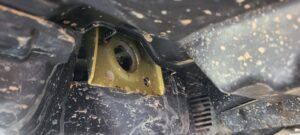Despite the backroad adventure lifestyle that many Soft-Roaders are marketed with, most manufacturers don't actually expect, or make provision for, you to get stuck. You may also not expect to ever get stuck, but when you leave the paved roads you should be prepared for the possibility.
A very very small percentage of Soft-Roaders are equipped with genuine Recovery points. These will typically be rated for at least 1.5 times the vehicle weight and are permanently attached to the vehicle with at least two bolts. It is usually very obvious you are looking at a true recovery point as it will be obviously built tough. Just be sure you are looking at the attachment to the vehicle and not simply a shackle that has been screwed onto a tow loop.

Recovery Point
Many (but not all) Soft-Roaders have Tow points. These are usually a loop on a threaded stud that is inserted through a pop-out panel on the bumper. These are designed to pull a vehicle with a dead battery or one that simply needs a little help due to loss of traction. If you can even find a rating it will usually be similar to the weight of the vehicle if it was empty. Try to use one of these tow points for a difficult recovery and you will likely rip the bumper right off your vehicle.

Tow Loop
Looking under your vehicle you may find loops built into or attached to the frame, but when you try to hook a strap to them you discover there is no way to connect the strap to another vehicle without potentially damaging your bumper. That is because these are tie-down points designed to secure the vehicle during transport. Like tow points they are, at best, rated for the weight of the vehicle. The good news is they are usually in pairs, so in an emergency you can connect to both for a recovery point with a decent rating. You are risking damage to the bottom of your bumper, but it's better than overloading a tow loop and ripping the bumper off.

Tie Down Point

Hard Shackle Connection

"Bridle" to both points
A class III, 2" trailer hitch with a shackle attachment is often the best recovery point for a Soft-Roader. They will almost always be rated for the full loaded weight of the vehicle (check the specs before buying one), attach with at least four bolts so the stress on the vehicle is spread out, and are usually easy to access when needed. You still are risking damage if you are stuck up to the doors in mud, but if you just got stuck in a shallow ditch or high-centered on a berm you can be confident that you can be gently tugged out. If you have a light vehicle like a Subaru, are not seriously stuck, and don't have a shackle attachment you can, in a pinch, put a strap on the hitch pin. This can result in bending the pin making it hard to remove, but even more importantly a bent pin will quickly and drastically lose strength. Never us just a hitch pin for a heavy vehicle or a serious stuck, and Never Never Ever loop a recovery strap over a tow ball. Its not what they are designed for and people are killed when they fail.
For a proper front recovery point you will typically be looking at an aftermarket bumper. The hard part is telling the difference between bumpers that are really just a rugged looking place to mount some extra lights versus an actual recovery point. If it doesn't give you a weight rating then don't trust it. You may even be able to find a winch bumper for your vehicle. This will, of course, be a recovery point, but the strength of it is still limited by the structure it is bolted to so check the ratings and focus on quality rather than installing a winch rated higher than the bumper.

Hitch Shackle

Winch Bumper
Watch for an upcoming article on recovery techniques for Soft-Roaders.

